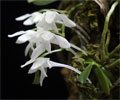|
|
|
|
|
| |
Flasks of
Mystacidium braybonae 'Beth's Bagatelle' CHM × self |
|
| |
|
|
| |
|
|
Click to Enlarge

Pod Parent Plant |
Click to Enlarge

Offspring 'MC3752' Flowers |
Click to Enlarge

Offspring 'MC3752' Flowers, Side View |
| Offspring photos are siblings of the plants you would receive. |
|
|
|
| |
Culture Notes from Donor: Parent plant: Temperature range I (60-83°F). Growing on a horseshoe and cork, likes a winter rest. The plant will tell you when to water (when you see active growth). This African species will need its roots exposed and dry at night.
Comments: Parent plant: Was awarded CHM 81 pts in 1993. See description and photo in AQ 25/133p. Miniature.
For additional origin/habitat information supplied courtesy of
Charles and Margaret Baker, see further below, near the bottom of this page.
|
Temperatures we attempt to use in the lab & greenhouse:
| For Species: |
|
Spring, Summer, Autumn: days average 86°F, nights 65°F; best fit is Warm-Intermediate 87-64°F
(Source:
Baker's Web OSC) |
| For Species: |
|
Winter: days average 74°F, nights 44°F; best fit is Cool 70-52°F
(Source:
Baker's Web OSC) |
|
About the name...
| Etymology of |
braybonae |
|
Named for Mrs. H. Braybon, South African orchid enthusiast of the 20th century.
(Source:
Mayr & Schmucker 1998) |
| Etymology of |
Mystacidium |
|
From Greek "mystax" moustache.
(Source:
Pridgeon 1992) |
| Pronunciation of |
Mystacidium |
|
mis-tah-SID-ee-um
(Source:
Pridgeon 1992) |
|
If you would like to direct someone to this web page, please copy and paste this URL into your email:
http://troymeyers.com/d?014365
|
|
| |
The origin/habitat information below is supplied courtesy of Charles and Margaret Baker
The following information is based on the name of the plant provided by the donor, and assumes that the name is correct. If the plant has been misidentified, then the following information may not be correct.
This text is copyrighted by the Bakers and may not be reproduced without permission.
ORIGIN/HABITAT: South Africa. This species is known only from the
Soutspansberg Mountains in Northern Province. Van Ede (1990) reported two
races of this species, with one race characterized by smaller plants found
in the western parts of the soutpansberg while the larger plants of the
other race inhabit the more eastern parts of the region. Plants typically
are found on fig trees growing on south-facing slopes where morning mists
are common, but they also occur on thorn trees together with Mystacidium
venosum. Habitat elevation for Mystacidium braybonae was not reported, but
Mystacidium venosum is found at elevations from near sea level up to about
4900 ft. (1500 m). Growers report that both species grows well at
intermediate temperatures, so we have estimated habitat elevation
accordingly, but growers should use the resulting climate table and
cultural suggestions somewhat cautiously until actual habitat elevations
are available.
More about this information and the Bakers...
|
|
|
| |
|
|
|